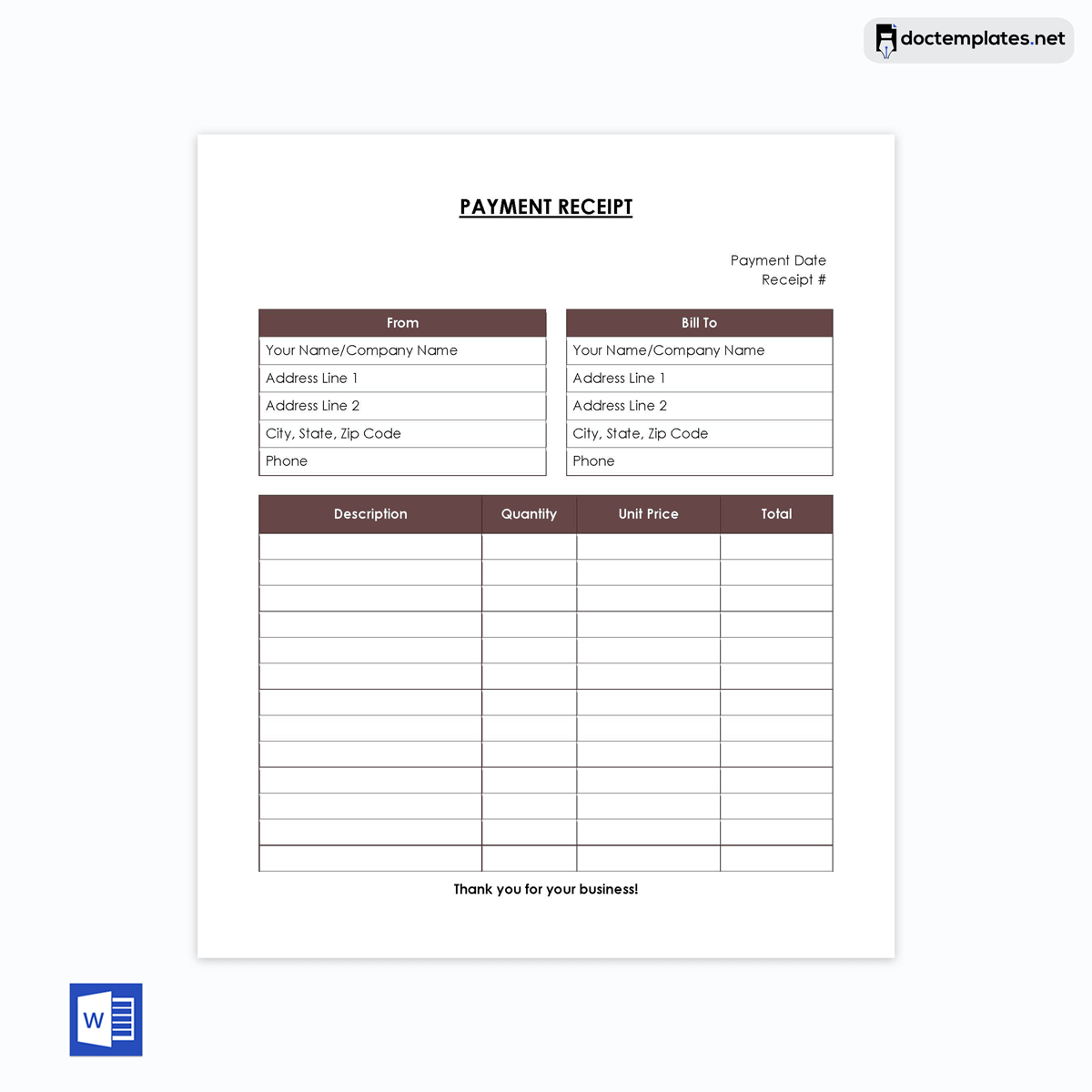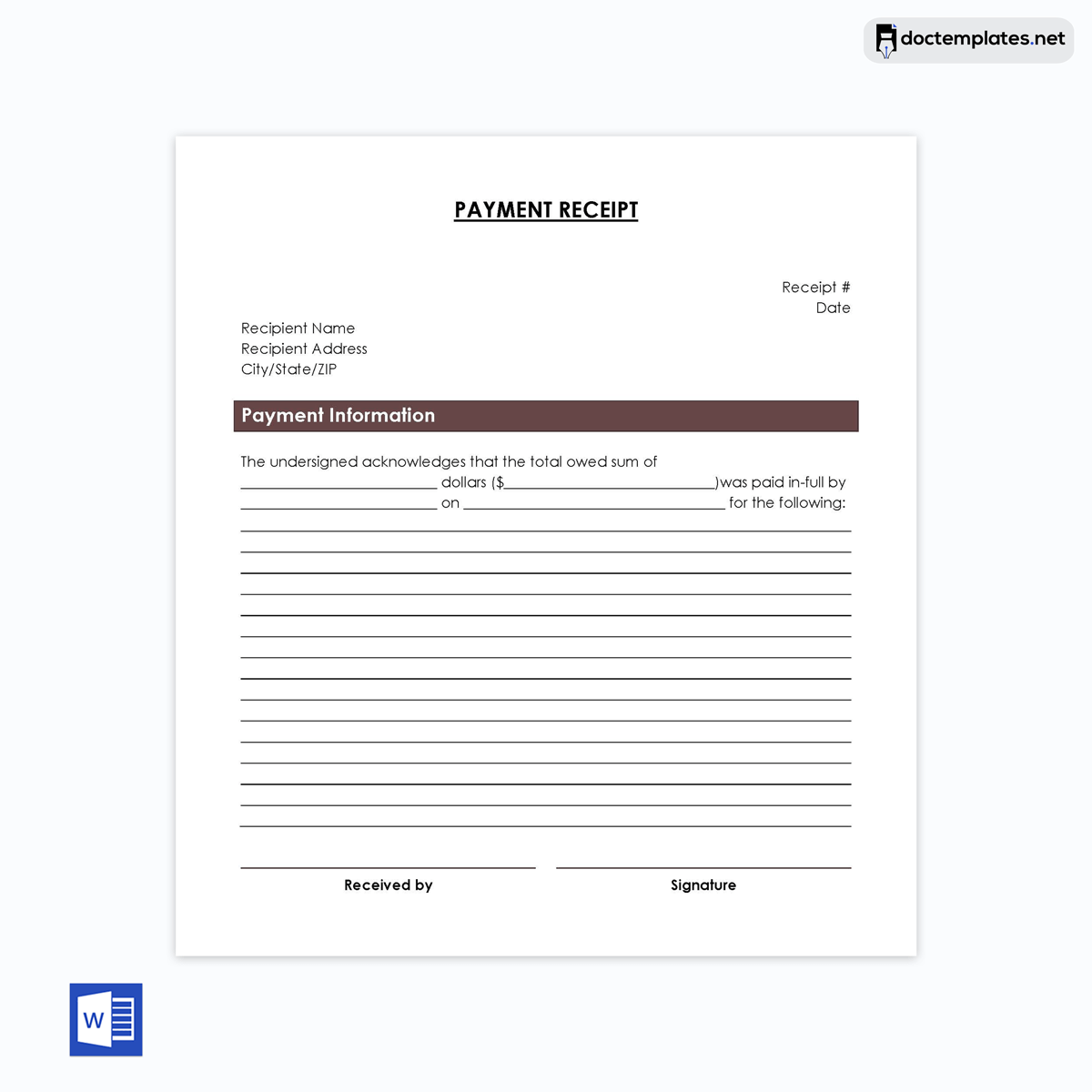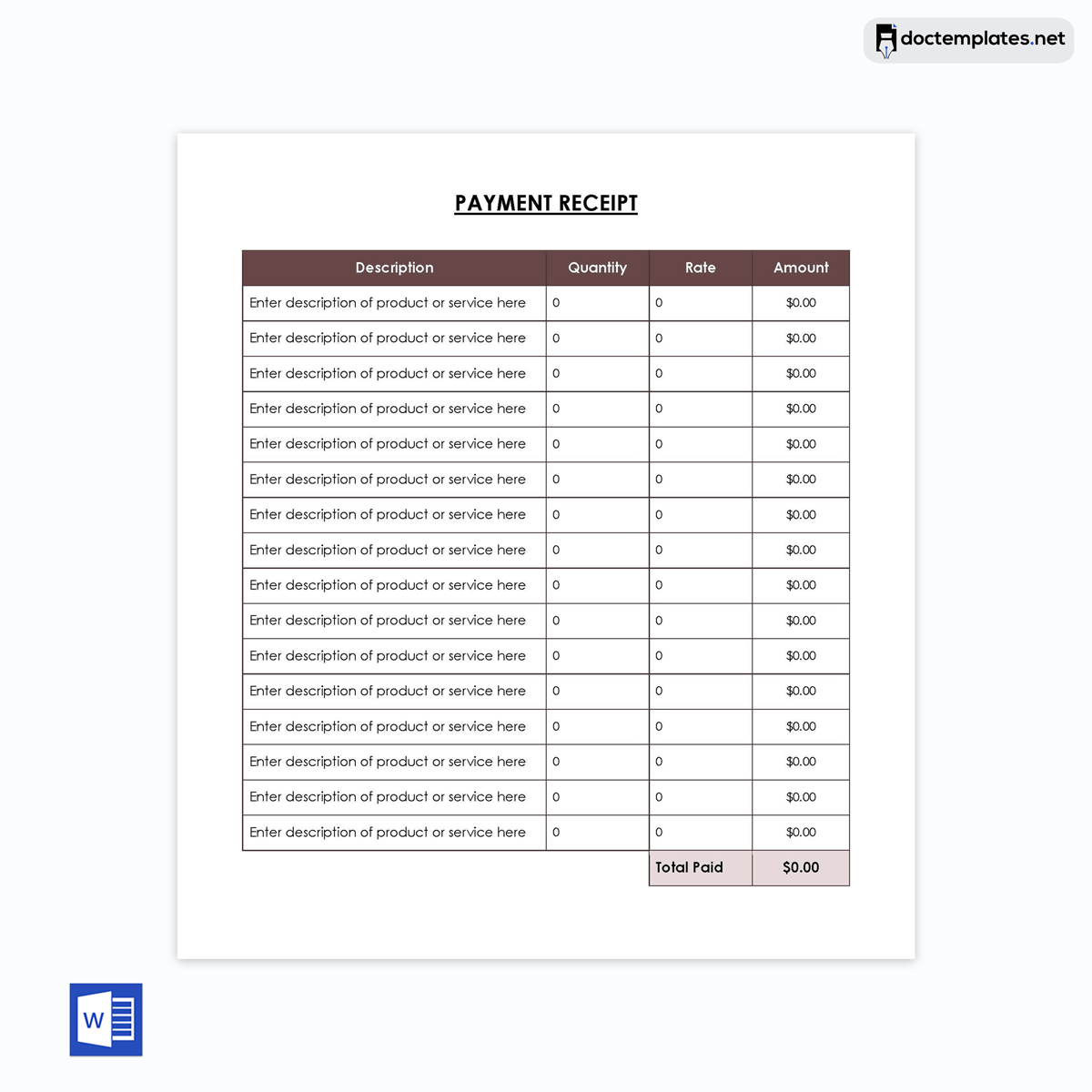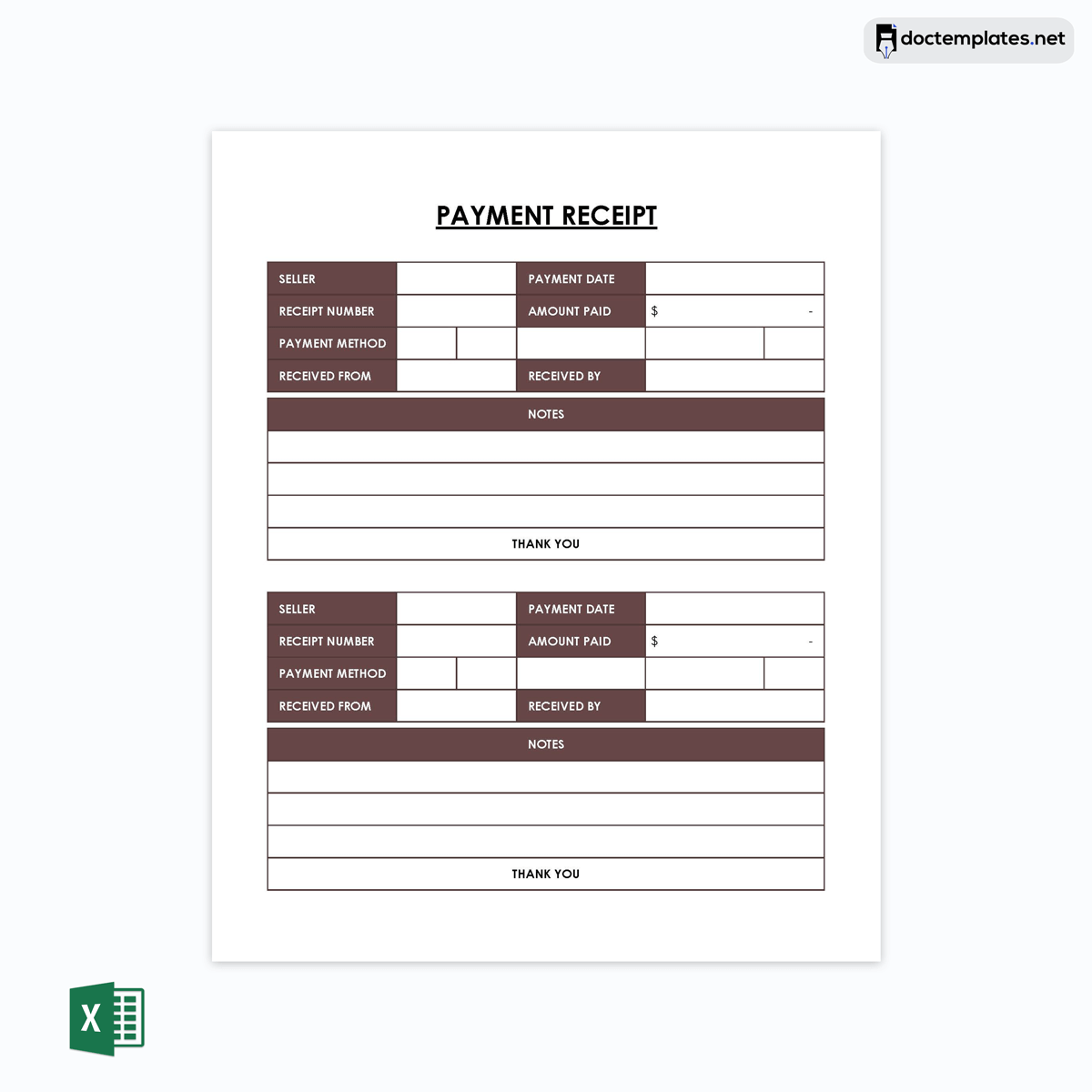Payment receipts are necessary business documents that allow you to acknowledge receiving payments for products and services customers acquired. Payment receipts are also called receipts of payment and should be issued after every transaction. This is because they indicate the amount paid after issuing products or services and any pending payments to be made by your customer.
Receipts of payment help you manage your business’ finances better. This is because they provide evidence that payments were made and help you keep track of your customers’ transactions. In addition, payment receipts give details about payments, enabling you to understand the products and services being paid for, the payment method, and whether your customer has made the full payment. Payment receipts are used across different industries, and you can utilize them in your business to improve your financial record-keeping.
This article helps you differentiate payment receipts from other business documents and explains how the receipts can help your business thrive. It also includes the essential details that should be incorporated in your payment receipt to make it complete.
Payment Receipt Templates
A payment receipt template allows you to acknowledge payments received for goods sold to your customers. A proper template helps you create the perfect payment receipt, boosting customer relations. Below are various free templates that can be downloaded and customized, allowing you to make a proper payment receipt for your business.
Advantages of a Payment Receipt
Receipts benefit your business by letting you acknowledge that you have received the payment for the product or service. This is because there are instances when you may need to give products to customers on credit to make partial payments. A receipt shows the payment made and the remaining amount for the customer to clear their debt.
The following are the advantages of using payment receipts in your business:
Plays a vital role in bookkeeping
Payment receipts help keep financial records in your business. This is because they indicate the total amount a customer paid for goods or services and their means of payment. That information is vital when evaluating the amount of revenue brought in by the business at the end of a financial year. You can also include different subtotals for the components of the product or service issued to help explain the total cost in the payment receipt. For example, if you make and sell furniture, you can indicate the cost of labor and materials and the amount of tax added.
It can be used across different industries
A payment receipt is easy to introduce to your business because it can be applied across many industries. Most industries involve selling a commodity or service in exchange for money, making it essential to issue a receipt to the customers upon payment.
Keeps track of your inventory
It is necessary to be aware of any pending payments to your business. This helps you avoid situations where you forget purchases made on credit which can lead to a loss. In addition, the receipt lets you know whether a product was paid for, allowing you to know pending payments and reach out to customers who have not completed their payments.
Avoid bad customer experience
Your business should ensure that your customers have the best experience to stay loyal to it and refer you to more clients. It is essential to avoid requesting payments from customers who have already paid, and receipts can help you do so. A receipt helps you know if a customer has paid upfront for your products or services, preventing you from accidentally asking them to pay again.
Keeps track of the debt
Your business can be structured so customers can acquire products on credit, and a receipt helps you manage that practice. For example, you can issue payment receipts to customers whenever they make payments to their credit purchases, allowing you to know the amount left to clear their debts. You also know when a customer is done paying for a product.
Payment Receipt Vs. Other Forms of Receipt
Some documents are necessary for your business since they help you keep track of transactions, making bookkeeping easier. Documents like quotations, invoices, payment receipts, and sales receipts are vital in your business, making it essential to use them. However, they may be confusing, and it would be best to know their differences to use them effectively. For example, a payment receipt is a document acknowledging that the payment for goods and services has been received. Upon payment, the receipt is issued to your customers to show the products and services they received, the amount paid, and how they paid.
Invoice
Invoices differ from payment receipts since they are only issued once a customer obtains a product or service. It is issued to your customers to notify them of their pending debt after acquiring the product or service from your business. It shows the total cost of the products and services given, the channels to be used in paying, and the date by which the payment should be made.
Sales receipt
The critical difference between a payment and a sales receipt is the time they are issued. A sales receipt is issued to your customers when they fully pay for the products or services. The receipt is issued when the customer pays using one means and indicates the date, list of items purchased, and the amount paid.
Also, sales receipts are more structured and do not have customer details or invoice numbers, making them resemble simplified invoices. In addition, sales receipts may contain tax implications and other specifics that contribute to the total amount paid by the customer.
What to Include in a Payment Receipt
Your payment receipt should contain your business’s details to inform your customers that the receipts came from you. It is essential to include details about the payment, such as the method of transaction, the amount paid, and the amount left by your customer to clear their balance, if any.
In addition, the information outlined below should be included in your payment receipt:
Label your document
A payment receipt can be easily confused with other business documents, making it mandatory to label your document by indicating at the top that it is a payment receipt. This helps your customer know the document’s purpose, allowing them to keep it for reference.
For example:
Receipt of Payment
Your company logo
Your company’s logo helps you market your business and promote your brand, making it necessary to include it in your payment receipt. Your logo also adds color to the payment invoice and ensures that your brand is cemented in your customers’ minds.
For example:
Schwaps
Your business name and contact details
Your business name identifies your business, distinguishing you from other businesses, and it should be included in your payment receipts. Your contact details should also be included since it ensures that your customers can easily retrieve your contact information whenever they want to communicate with you.
An example is:
Jack n’ Jones Stationers
29 Pineville St
019-589-405
The invoice number
An invoice is usually issued when customers acquire products or services on credit. It is essential to add the invoice number on the payment receipt to indicate that you received payment for a particular invoice. This helps in bookkeeping since the invoices are linked to payment receipts and having the number on your receipt makes your work easier.
For example:
INV. 085521
The payment date
The payment receipt should include the date your customer made the payment. This is because it allows your customer to link the receipts to the payments they made.
For example:
30-12-2021
The amount paid
The total amount paid by your customer should be indicated on the payment receipt. Your customers may need to confirm whether the total amount they paid was received, and your payment receipt should relay the correct figures.
For example:
Total: €1,700
Payment method
Various payment methods can be used, from cash payments to electronic and credit card transactions. For future reference, it is essential to indicate the method your customer uses to pay and give details about the payment, such as the transaction code.
For example:
Payment via Mastercard, Card No. XXXX YYYY ZZZZ 1690
The remaining balance
Your customer may have made a partial payment on their total invoice, and it is vital to indicate the amount remaining to clear their balance. This ensures they are aware of their debt, allowing them to work on clearing it. You should also indicate on the payment receipt if the customer has fully paid for the products they received.
For example:
The total amount paid: €700
Remaining balance: €1,960
Frequently Asked Questions
Is it mandatory to issue a payment receipt?
According to the law, your business can operate without issuing payment receipts. However, your business should embrace issuing receipts if you want it to become successful. This is because you can provide proof of payments to your customers and keep bookkeeping records. Therefore, if your customer requests a payment receipt, oblige and provide them with one.
How to create a receipt of payment?
There are no formal requirements when creating a payment receipt, but there are details that must be included. Your business details are vital, making it necessary to include your logo, name, and contact details. In addition, it is essential to include details about the payment, such as the invoice number, the date it was made, and the amount paid. You should also indicate whether the customer has fully paid for their products and, if not, indicate the amount remaining to clear the debt.
Should I keep all my payment receipts?
Payment receipts are valid business documents and should be kept safely. This is because the receipts can be used in bookkeeping, and this information is used to evaluate your business’s finances, ensuring that your financial records are in line with tax regulations. Payment receipts also help you know whether your customers have fully paid their debts, allowing you to reach out to only those who have not completed their payments. This helps avoid errors when handling customers and keeps you from forgetting pending payments.





